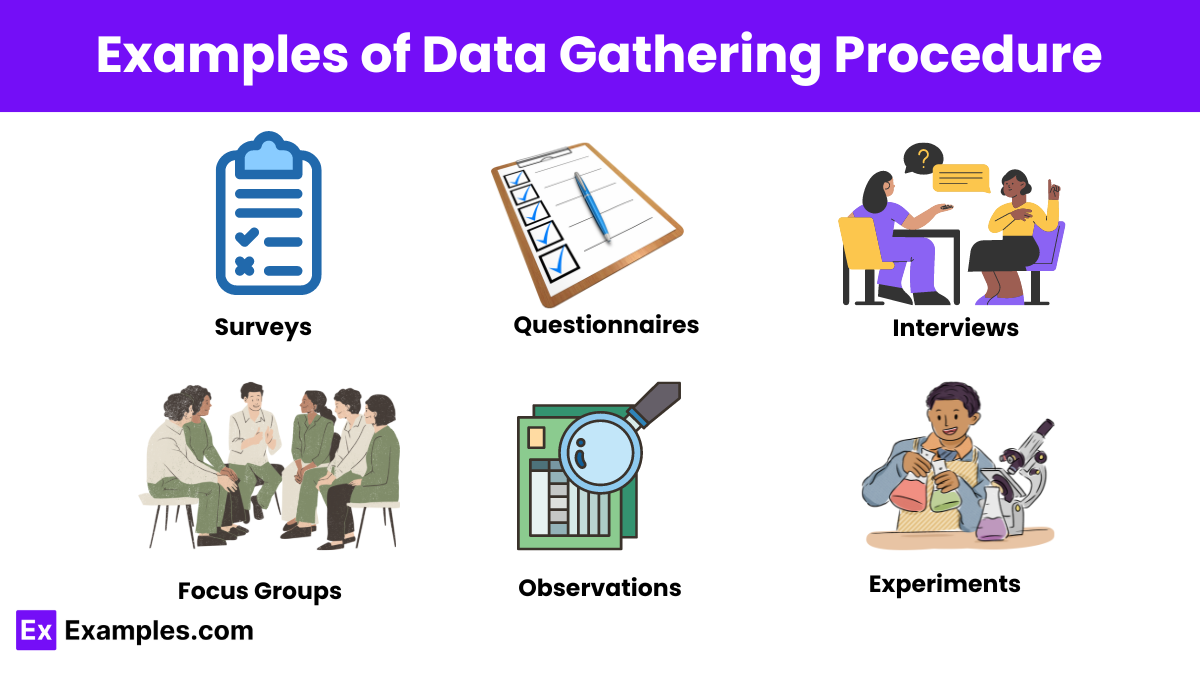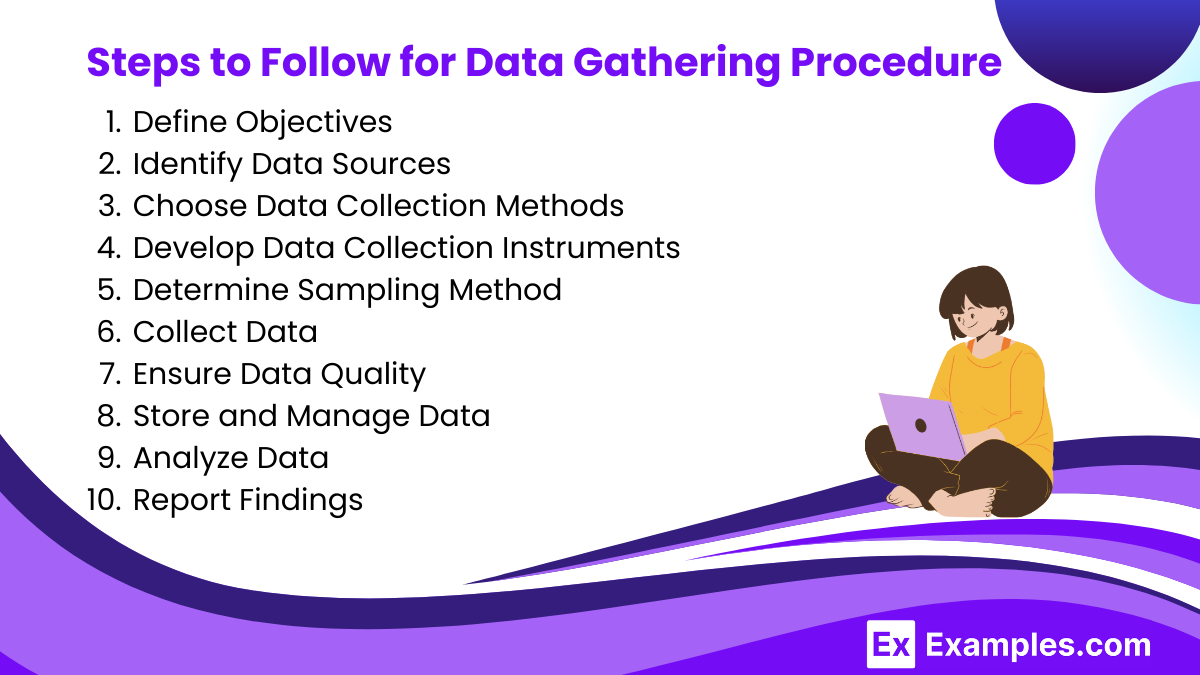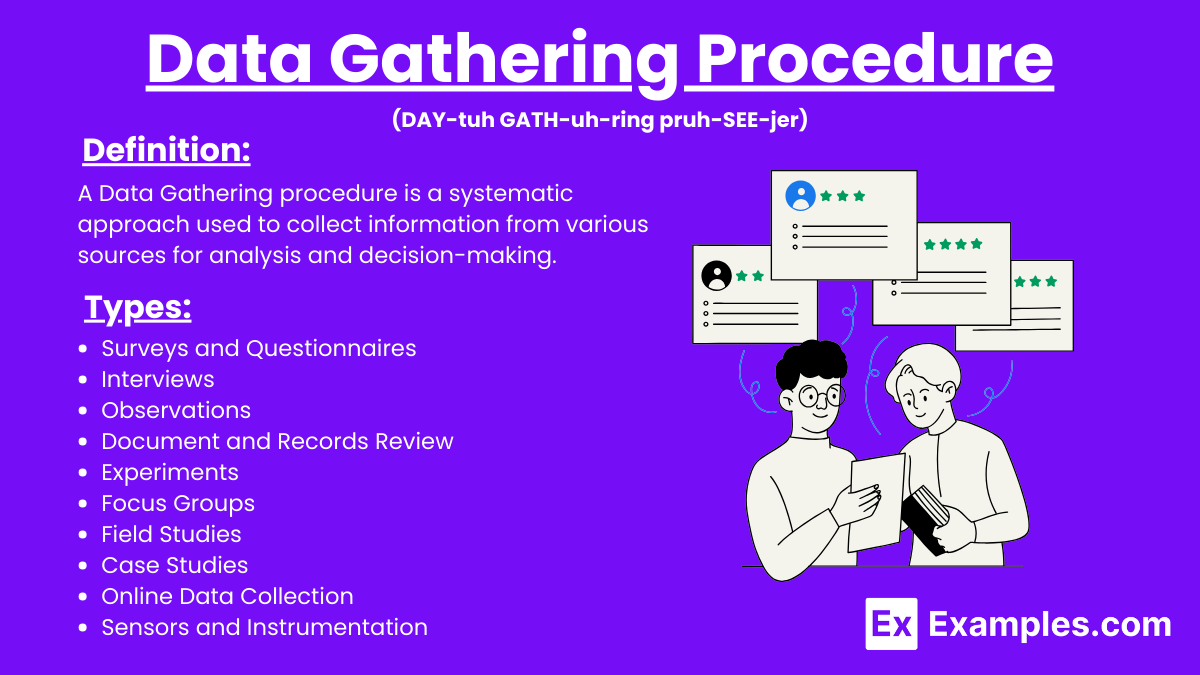15+ Data Gathering Procedure Examples to Download
A data gathering procedure is a systematic approach used to collect information from various sources for analysis and decision-making. This process ensures that the data collected is accurate, reliable, and relevant to the specific objectives of a study or project. As part of this procedure, conducting a data gap analysis identifies any missing information that could affect the results. Implementing a data quality assurance plan ensures that the data collected meets predefined standards of accuracy and reliability. The findings are then compiled into a data analysis report for thorough evaluation. Additionally, when applying for a related position, a data analyst cover letter should highlight your expertise in these areas to demonstrate your proficiency in data management and analysis.
What is Data Gathering Procedure?
Examples of Data Gathering Procedure

- Surveys
- Questionnaires
- Interviews
- Focus Groups
- Observations
- Experiments
- Sensor Data Collection
- Online Polls
- Web Analytics
- Social Media Monitoring
- Transaction Records
- Case Studies
- Field Research
- Database Mining
- Content Analysis
Types of Data Gathering Procedure
Data gathering procedures can be categorized based on the nature of the data and the methods used to collect it. Here are the primary types:
1. Surveys and Questionnaires
- Description: Collecting data through structured sets of questions provided to respondents.
- Usage: Commonly used in market research, social sciences, and customer feedback.
- Methods: Can be conducted via online forms, paper forms, or telephone.
2. Interviews
- Description: Gathering detailed information through direct interaction with individuals.
- Usage: Used in qualitative research, journalism, and human resources.
- Methods: Can be face-to-face, over the phone, or via video conferencing.
- Types: Structured (fixed set of questions), semi-structured (guided with some flexibility), unstructured (open-ended and conversational).
3. Observations
- Description: Collecting data by watching and recording behaviors or events as they occur.
- Usage: Common in social sciences, anthropology, and usability testing.
- Methods: Participant observation (researcher is involved in the activity), non-participant observation (researcher observes without direct involvement).
4. Document and Records Review
- Description: Analyzing existing documents and records to gather data.
- Usage: Used in historical research, policy analysis, and compliance audits.
- Methods: Reviewing reports, memos, meeting minutes, financial records, and more.
5. Experiments
- Description: Conducting controlled tests to gather data on specific variables.
- Usage: Common in scientific research, psychology, and product testing.
- Methods: Laboratory experiments, field experiments, and A/B testing.
6. Focus Groups
- Description: Collecting data through guided group discussions on a particular topic.
- Usage: Used in market research, product development, and social research.
- Methods: Facilitated discussions with a small group of participants to explore opinions and attitudes.
7. Field Studies
- Description: Collecting data in a natural setting where the phenomenon occurs.
- Usage: Common in ecology, anthropology, and social sciences.
- Methods: Involves immersive observation and interaction in the natural environment.
8. Case Studies
- Description: In-depth analysis of a single case or a small number of cases.
- Usage: Used in business, law, education, and social sciences.
- Methods: Comprehensive examination of documents, interviews, and observations related to the case.
9. Online Data Collection
- Description: Using digital tools and platforms to gather data.
- Usage: Common in modern market research, social media analysis, and web analytics.
- Methods: Web surveys, social media monitoring, data mining, and online forums.
10. Sensors and Instrumentation
- Description: Using devices to measure and record data from the physical environment.
- Usage: Common in environmental science, engineering, and healthcare.
- Methods: Sensors for temperature, humidity, movement, and medical instruments.
Importance of Data Gathering Procedure
Data gathering is crucial because it provides the foundation for informed decision-making and strategic planning. Accurate and comprehensive data collection allows organizations to understand trends, identify opportunities, and address challenges effectively. It enhances the reliability of research findings, supports evidence-based practices, and ensures that decisions are grounded in factual information. Moreover, systematic data gathering helps in tracking performance, measuring outcomes, and improving processes, ultimately contributing to the success and sustainability of businesses, academic research, and various other fields. The information collected is often compiled into a data report for detailed review. Data analysis is then performed to extract insights, while data analytics in business helps drive strategic decisions and optimize operations.
Steps to Follow for Data Gathering Procedure

Data gathering is a critical process that requires careful planning and execution. Here are the key steps to follow:
1. Define Objectives
- Purpose: Clearly outline the goals and objectives of the data collection process.
- Questions to Ask: What information is needed? Why is it needed? How will it be used?
2. Identify Data Sources
- Primary Sources: Direct sources such as surveys, interviews, and observations.
- Secondary Sources: Existing data such as books, reports, and online databases.
3. Choose Data Collection Methods
- Surveys and Questionnaires: Structured tools for collecting data from a large audience.
- Interviews: Detailed, qualitative data through direct interaction.
- Observations: Recording behaviors or events as they occur.
- Document Review: Analyzing existing documents and records.
4. Develop Data Collection Instruments
- Design Tools: Create surveys, interview guides, observation checklists, etc.
- Pilot Testing: Test the instruments on a small scale to ensure clarity and reliability.
5. Determine Sampling Method
- Sampling Techniques: Random sampling, stratified sampling, or convenience sampling.
- Sample Size: Ensure the sample is representative of the larger population.
6. Collect Data
- Implement Plan: Use the selected methods to gather data.
- Maintain Consistency: Follow the planned procedures to ensure data consistency and reliability.
7. Ensure Data Quality
- Validation: Check for accuracy, completeness, and consistency of data.
- Address Issues: Correct any errors or inconsistencies found during validation.
8. Store and Manage Data
- Data Organization: Organize data systematically for easy access and analysis.
- Secure Storage: Ensure data is stored securely to protect confidentiality and integrity.
9. Analyze Data
- Data Analysis Techniques: Use statistical tools and methods to interpret the data.
- Extract Insights: Identify patterns, trends, and key findings.
10. Report Findings
- Documentation: Prepare a detailed report of the data collection process and findings.
- Presentation: Share the results with stakeholders through presentations, reports, or dashboards.
Common Challenges in Data Gathering Procedure
Data gathering is a crucial process in research and analysis, but it comes with several challenges that can impact the quality and reliability of the collected data. Here are some common challenges:
1. Data Quality and Accuracy
- Issue: Ensuring that the data collected is accurate and reliable.
- Impact: Poor data quality can lead to incorrect conclusions and decisions.
2. Sampling Issues
- Issue: Choosing a representative sample size and method.
- Impact: Biased samples can skew results and reduce the validity of the study.
3. Respondent Availability and Willingness
- Issue: Difficulty in reaching respondents and securing their participation.
- Impact: Low response rates can lead to incomplete data and less reliable results.
4. Data Privacy and Confidentiality
- Issue: Ensuring the privacy and confidentiality of respondents’ information.
- Impact: Breaches can lead to legal issues and loss of trust.
5. Resource Constraints
Issue: Limited time, budget, and personnel for data collection.
Impact: Resource constraints can lead to shortcuts that compromise data quality.
6. Data Integration and Compatibility
- Issue: Combining data from different sources and formats.
- Impact: Incompatibility can lead to difficulties in data analysis and interpretation.
7. Technological Challenges
- Issue: Using and maintaining data collection tools and technologies.
- Impact: Technological failures can result in data loss or inaccurate data collection.
8. Cultural and Language Barriers
- Issue: Differences in culture and language among respondents.
- Impact: Misunderstandings and misinterpretations can affect data accuracy.
9. Ethical Considerations
- Issue: Ensuring ethical standards in data collection.
- Impact: Ethical breaches can lead to harm to participants and discredit the research.
10. Data Overload
- Issue: Collecting excessive amounts of data.
- Impact: Data overload can make analysis complex and time-consuming, potentially obscuring key insights.
Uses of Data Gathering Procedure
- Informed Decision-Making: Data gathering procedures provide accurate and relevant data, enabling organizations to make informed decisions. By systematically collecting and analyzing data, businesses can identify trends, opportunities, and potential risks, leading to better strategic planning and problem-solving.
- Market Research: In business, data gathering is crucial for market research. It helps companies understand customer needs, preferences, and behavior. This information is essential for developing effective marketing strategies, product development, and competitive analysis.
- Performance Measurement: Organizations use data gathering procedures to measure performance and track progress toward goals. Key performance indicators (KPIs) and other metrics are collected and analyzed to assess efficiency, productivity, and overall performance.
- Product Development: Data gathering is used to collect feedback from customers and stakeholders during the product development process. This feedback helps businesses understand user requirements, identify potential issues, and improve product design and functionality.
- Quality Control: In manufacturing and service industries, data gathering procedures are used to monitor and control quality. By collecting data on processes, materials, and outputs, organizations can identify defects, improve quality, and ensure compliance with standards.
- Academic Research: Researchers in academia rely on data gathering procedures to collect empirical data for their studies. This data is essential for testing hypotheses, validating theories, and contributing to knowledge in various fields.
- Public Policy and Planning: Governments and public organizations use data gathering to inform public policy and planning. This includes collecting data on population demographics, economic conditions, health statistics, and environmental factors to develop effective policies and programs.
How do you choose a data gathering method?
Choose based on the research objective, target population, resources available, and the type of data needed.
What is qualitative data gathering?
Qualitative data gathering involves collecting non-numerical information to understand concepts, opinions, or experiences.
What is quantitative data gathering?
Quantitative data gathering involves collecting numerical data that can be measured and analyzed statistically.
How do you ensure data accuracy?
Ensure data accuracy by using reliable sources, well-designed instruments, and consistent data collection procedures.
What is a survey?
A survey is a data gathering tool that uses questionnaires to collect information from a large number of respondents.
What is an interview?
An interview is a data gathering method where one-on-one or group conversations are conducted to obtain detailed information.
What is observation in data gathering?
Observation involves systematically watching and recording behaviors or events as they occur naturally.
What is secondary data?
Secondary data is information that has already been collected and published by others for different purposes.
How do you gather secondary data?
Gather secondary data from sources like books, academic journals, government reports, and online databases.
What are the benefits of using secondary data?
Secondary data saves time and resources and provides a basis for comparison and further research.


